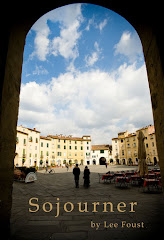In case you're perhaps curious about this book, knowing that it's quite
an investment of your time at 600+ pages, I thought I'd write a few
words about it to fill you in.
Here's its history:
Back in
the mid-1980s, I had an idea for a novel. I had recently survived a
typical twenty-something banal kind of male sexual trauma that, even if
trivial by a lot of standards, had shaken me deeply and I wanted to
write something about it. I had studied Creative Writing at uni, had
already collected nine of my best short stories into an idea for a book
of crossover, interlocking stories that might do for the Bohemian
community in San Francisco of the early '80s what James Joyce's Dubliners had done for its author's vision of that city and its people at the turn of the last century. (That's my first book, Poison and Antidote.)
Given
the scent of postmodernism was wafting through the air in those days, I
framed my love trauma story as a retelling of the myth of Persephone's
abduction by her uncle Hades and then partial restitution to her mother,
Demeter. I switched the mother to the lover and started off writing.
That, my first novel, Inbetween,
went through quite a few permutations before it saw the light of
day--primarily, I used Dante Alighieri's lovely little book or "libello"
as he calls it, the Vita Nova to give my non-chronological love
story a sort of narrative frame. I did this partly because I thought
Dante's odd little prosy-metrum (a text combining verses and prose
sections) was the best book I'd yet read about love, so it seemed a
worthwhile model, and partly because of that author's famed Inferno, which seemed oddly to link up with my framing of an extra-relationship affair as a journey to hades and back.
Having
done all that suggested rather strongly to me, then, that my next two
novels should explore purgatory and paradise, as Dante's model urged me,
reshaping these concepts for a new generation, a new century, myself,
whatever. I'm therefore thrilled to announce that as of today, June
27th, 2024, by publishing The Three Living Meet the Three Dead I've completed the trilogy I call The Divina Vendetta (a quotation from the Florentine's epic poem) that I conceived of writing back in 1985.
If you're interested in the Purgatorial entry, it's called Here Lies: The Remains of Francesco Castello, AKA Borromini.
I framed that novel as the purgatorial testament of 16th century
Baroque architect Francesco Borromini, but it's a loose, punk rock kind
of historical novel in which the author's and the subject's lives
converge, contradict, and merge occasionally as they make their way up
Dante's purgatorial mountain, confronting each of the seven deadly sins
in turn and trying to decide if salvation is really worth the trouble.
Which
brings me to the present volume. If you've read the above blurb you're
probably thinking that a novel-in-frames made up of 42 tales told by six
storytellers sounds much more like Boccaccio's Decameron, Chaucer's Canterbury Tales, Marguerite de Navarre's Heptameron, or even Jan Potaki's delightful The Manuscript Found in Saragossa.
And in that you'd be right: as a man obsessed with narrative, reading,
and writing, I can think of no better paradise than a group of people
sitting around a campfire telling stories. So that's how I wrote it.
The title and the set-up for the frame story comes from a common medieval memento mori
tale and art subject in which three nobleman in all of their finery go
a-hawking, only to be admonished at the crossroads when they come upon
three skeletons who remind them that wealth isn't everything--indeed is
really nothing at all to be proud of.
Since Dante's Vita Nova and Purgatorio
had given me the framework for the first two volumes of my trilogy, I
followed suit here. I felt that I needed some logical way of arranging
my tales and I therefore adopted the way that the Florentine poet
arranges the spirits of the blessed in the Paradiso, for the
various qualities associated with the seven celestial spheres. Thus,
over the course of seven nights, my six taletellers seek to drag
narratives from out of both the land of the living and that of the dead,
thematically from out of the spheres of the Moon, Mercury, Venus, Sol,
Mars, Jupiter, and Saturn.
As for the tales themselves, early on,
given that I had three reanimated corpses already as narrators and
since I already had a loose thematic structure, I opted for anarchy over
order in terms of chronology, style, and form. The tales are thus a
cornucopia of ideas, styles, and structures, everything that I could
think of that entertained me--and I hope you.
There is realism
and fantasy, monologue, dialogue, and multi-voiced, chronological,
multi-scened, and a couple of dual-narratives I think came out
particularly well. There's classical, medieval, and modern (and even a
couple of tales out of the future)--as well as blendings of the three.
There's tragedy and comedy, a lot of prose and a little bit of verse,
parody and plagiarism, and, following Chaucer and Boccaccio, everything
from saint's lives to obvious autobiography. There are rich and poor,
noble and base, gentile, Jew, and pagan, male and female, straight and queer, and even one
transsexual voice telling the tales. The themes of the spheres
themselves are loosely: Moon = inconstancy and resurrection; Mercury =
theft and transformation; Venus = Love and friendship; Sol = philosophy
and praxis; Mars = war and bullying; Jupiter = justice and outrage; and
Saturn = art and self-recreation.
I hope you enjoy it half as much as I've enjoyed these forty years of writing it for you.
Cheers,
Lee
Links to purchase:
Volume one: https://www.blurb.com/b/12044424-the-three-living-meet-the-three-dead-vol-1
Volume two: https://www.blurb.com/b/12044426-the-three-living-meet-the-three-dead-vol-2











